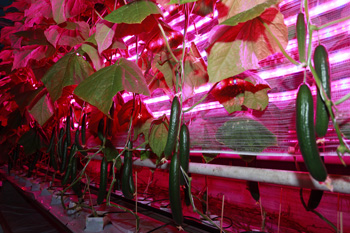- News
23 November 2010
Osram’s TOPLED LEDs used in Netled’s horticultural lighting
Osram Opto Semiconductors GmbH of Regensburg, Germany says that millions of its TOPLED LEDs are being used by Tampere-based agricultural lighting specialist Netled Oy in a horticultural lighting system in Honkajoki, Finland.
 Designed and installed in a curtain structure of 10 strips each measuring 25m in length, the LED lighting replaces high-pressure sodium (HPS) lamps that are traditionally deployed in greenhouses. By creating the right wavelengths and intensity, the lighting installations are expected to achieve energy savings of up to 60%, says Osram Opto.
Designed and installed in a curtain structure of 10 strips each measuring 25m in length, the LED lighting replaces high-pressure sodium (HPS) lamps that are traditionally deployed in greenhouses. By creating the right wavelengths and intensity, the lighting installations are expected to achieve energy savings of up to 60%, says Osram Opto.
Picture: Netled’s horticultural lighting.
HPS lamps are widely used in horticulture to create the right environment for plants to grow in the dark season. A typical 1 hectare greenhouse using HPS lamps consumes about 10,000MW-hrs of electricity per year. “Based on some research, we found that only 7% of the light created by HPS lamps is absorbed by the plants. Much of the energy is wasted by inefficiencies,” says Netled's Niko Kivioja. “By converting into LED lighting, energy saving can be achieved immediately,” he adds. “In the case of lettuce grown in a greenhouse, energy consumption can even be reduced by 20–30%.”
Furthermore, the patent-pending curtain structure also reduces light pollution in the skyline, which is an issue in high-density population areas around northern territories and Asia.
In addition, according to recent studies, certain wavelengths and color temperatures can make the fruit quantity, weight or biomass grow more quickly. By using more pre-defined light, for example in growing tomatoes, the joules spent per kilogram of vegetables can be reduced. With cucumbers, the yield can be increased by more than 20%, the vegetable quality is improved, and the production season can be be lengthened.
The cost of electricity in Finland is rising by more than 15% annually, which will have an enormous effect on the food industry in the years to come, reckons Kivioja. Netled therefore aims to provide affordable solutions to decrease lighting costs for horticultural production, he adds.
Cultivation in greenhouses is becoming more significant, says Osram Opto. Through greenhouse-based farming, profitable and high-demand plants have become more cultivated. However, the total area of greenhouses in Scandinavia is 1400ha, which is less than the 2000ha in Canada and 2100ha in Japan. Furthermore, there is huge market potential for LED lighting in the Nordic countries, central Europe, and in Canada due to the significant period of darkness, the firm adds.
“The LED installation in Honkajoki has important implications for greenhouse farming in Scandinavia,” says Kai-Chung Cheng, marketing director of Osram Opto Semiconductors Asia Ltd. “It also proves that the features of LEDs such as small form factor, high efficiency and long life-span provide flexibility for lighting designers to make their ideas into reality,” he adds.
The project has been initiated by Netled in terms of research and promotion and Amity in terms of design and development, while the lighting system was manufactured by BCM in Malaysia.
